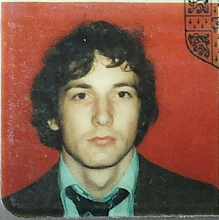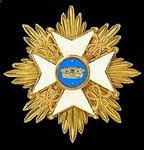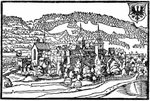[The flags are perhaps not some of the more attractive or complex Prussian flags, but the regiment certainly had an "exciting" war and was very highly regarded by Frederick. If I do only the more attractive flags at first I would have to end with a rather big swathe of the "boring" ones!]
The regiment was first raised in 1683.
Chefs in the Seven Years War were: Colonel Dietrich Erhard von Knobloch, later Major General to the 12th May 1757; Major General Gottlob Ernst von Pannwitz to the 10th February 1759; Major General Friedrich Wilhelm von der Mosel to 1768
IR 10 was with the King's army in the invasion of Saxony in 1756 but not at Lobositz. At the battle of Prague on May 6th 1757 it was part of Keith's Corps which was to the west of Prague, securing communications for the army. When the King lifted the siege of Prague on June 19th Keith's troops went back to Leitmeritz. The grenadiers of IR10 (9/10), who had fought at Kolin (with around 30% casualties - Duffy Army of Frederick the Great 1st Edition henceforth AFG1), were captured defending the town of Gabel. In August the regiment was part of the corps that went to Silesia with the Duke of Braunschweig-Bevern. It fought at Moys on September 7th when Frederick's close friend and eminence grise Winterfeldt was killed, quite possibly shot in the back by his own men from infantry regiment 32 Tresckow, which was largely made up of Catholics from Upper Silesia. On 22nd November the regiment fought in the defeat of Breslau and was then at Leuthen on December 5th. There, along with the Guard, it took part in repeated attacks on the churchyard at Leuthen, the main Austrian strong point, and lost 12 officers and 741 men (which according to AFG1 was distributed evenly between the 2 Battalions at around 50% losses each). The king praised the regiment's conduct most highly. The regiment ended the year at the siege of Breslau on December 19th.
In 1758 the regiment marched with the King's army to besiege Olmütz from June 1st to July 1st. The grenadiers were part of the force protecting the move back to Troppau, and were attacked from June 28th at Gundersdorf and Domstadtl. It stayed behind in Silesia with the Margrave Karl when the King went to Zorndorf and then joined Fouqué's Corps which was used to secure the main army's left wing while the King was encamped at Schmottseiffen.
In 1760 Fouqué's Corps had only 12,000 men including the 1st Battalion of IR10, after various units were transferred away. The 2nd Battalion was in Neisse and the grenadiers with Prince Heinrich's Corps until Freiberg in 1762. On June 17th 1760 Fouqué took up a fortified position at Landeshut but was then surrounded by an Austrian force under Laudon three times the size of his own. On the night of June 23rd Fouqué's force was attacked from two sides. Laudon reported that: "Height after height had to be torn away from the Prussians by bitter counterthrusts, one mountain after another, the entire withdrawal in the best order, step by step". Repeated demands to surrender went unheeded. IR10's 1st Battalion's surviving 328 men were captured. The King compared the defeat at Landeshut to the Greek fight at Thermopylae. (See Duffy By Force of Arms for a detailed account of Landeshut.)
Brought back up to strength, IR10 fought at Burkersdorf on July 21st 1762, its officers receiving 2 Pour-le-merite medals for their courage attacking the north slope of the position.
Christopher Duffy in his Army of Frederick the Great says this was: "another good Westphalian regiment, and notable for the enthusiasm of its cantonists. At the beginning of the Seven Years War Frederick questioned whether it would fight well against the French; an officer put his mind at rest, citing the superiority of "pumpernickel and Westphalian ham" over the "cakes and frogs' legs" of the French. It was very highly rated by Frederick in his somewhat capricious assessment of his army's performance in the 1760s.
And this was the musketeer uniform in 1756:




















Hello, I just discovered this site and my Lord this is incredible!Thank you very much for this dedication and efforts. CPN
ReplyDeleteThank you; glad you like it! :-)
ReplyDeleteCheers,
David.
I'm going to call it 'Teal', but a nice and different colour, which is always good to see. Excellent work as always:)
ReplyDeleteThanks, Steve. Teal it is! ;-) The next one, IR34, will have a plain light blue sheet but with white darts - nothing controversial!
ReplyDeleteAll the best,
David.